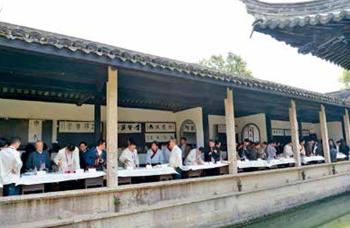高名今向世间传
雷彦平



海外篇
“实际上,在中国没有任何一位艺术家能比王羲之获得更普遍的崇拜。”瑞典著名学者喜仁龙1933年在《中国早期绘画史》一书中如是评价王羲之。
因为有了王羲之的《兰亭序》,浙江绍兴拥有兰亭书法节便是理所当然的事了。
兰亭书法节至2019年已成功举办35届,在国际书法界享有盛誉。自20世纪80年代以来,兰亭书会与日本的东京、福冈、福山、兵库、栃木等城市的书法界交流互动频繁。1985年至1987年,中日兰亭书会连续3年在绍兴兰亭举办,特别是1987年的中日兰亭书会,沙孟海、启功、青山杉雨、村上三岛等41位书法大家云集绍兴,盛况空前,成为中日书法交流史上的传奇与高峰。
王羲之书法自唐朝传之海外,在日本大受追捧,继而影响到整个汉字文化圈。
从公元7世纪到9世纪,日本遣唐使先后带回王羲之、王献之众多墨迹及临摹品,中国高僧鉴真和尚东渡日本时也带去过王羲之的墨迹,日本《扶桑略记》有载,鉴真和尚“舶载来王羲之行书一帖”。
千年一醉兰亭序,高名今向世间传。《兰亭序》一文的第一篇西文翻译,是意大利传教士晁德莅(1826~1902)在其《中国文学教程》(Cursus litteraturae sinicae,)中的一篇拉丁文翻译。“实际上,在中国没有任何一位艺术家能比王羲之获得更普遍的崇拜。”瑞典著名学者喜仁龙1933年在《中国早期绘画史》一书中如是评价王羲之。
意大利汉学家毕罗
欲用英文为王義之立传
2019年12月22日,阴雨绵绵。绍兴图书馆,一场名为《〈集王圣教序〉与王羲之书法真迹》的讲座开讲,由来自意大利那不勒斯的著名汉学家毕罗主讲。报告厅内座无虚席,绍兴近百名书法家及书法爱好者颇有兴趣地听意大利人解读王羲之书法。“毕罗幽默风趣,学术性、开放性、深入度都很好,他的学识、见解令人叹服。”在现场听过讲座的一位绍兴书法家回忆。
今年42岁的毕罗是当代屈指可数的著名汉学家,独立学者。毕罗多次留学中国,行走中国书法界20年,以研究孙过庭《书谱》切入中国书法研究。
毕罗才华横溢,会作古诗,写得一手漂亮小楷,能说一口流利的普通话()。
毕罗对《集王圣教序》评价很高。“真正能够让我们窥见王羲之书法面貌的较为可靠的作品是著名的《集王圣教序》。”他说。
公元672年,以玄奘为首的长安城僧人,委托弘福寺怀仁和尚,集合王羲之行书作品上的字刻成《集王圣教序碑》。操刀刻石者都是当时的顶尖高手。此碑现藏西安碑林。
2019年兰亭书法节,毕罗向绍兴论坛提交了论文——《从唐代集字碑看王羲之真迹的存亡》,提出“在王羲之现存作品当中,能够真正代表王羲之书风的真迹不超过12幅墨迹,一共734字”。他也是2019绍兴论坛在兰亭书法博物馆成立的二王学研究中心的唯一的西方专家。
毕罗曾数次来绍兴参加有关王羲之的学术活动。据了解,毕罗希望王羲之书法在西方更有影响,并多次表达了与绍兴方面合作的意愿。“将来,我一定要用英文写一部《王羲之》。”2019年6月,毕罗在与中国书法家张天弓谈话时说。他研究《集王圣教序》的专著——《尊右军以翼圣教》即将由四川人民出版社出版,其英文版计划明年在德国出版。
日本书坛巨匠宇野雪村
与兰亭书法家的翰墨情缘
宇野雪村先生是日本书坛巨匠,“前卫派”书法领袖人物,生前系日本奎星会代表,玄美社主持人,每日展审查委员,大东文化大学教授,对王羲之书法研究精深。
1987年3月,“启功、宇野雪村巨匠书法展”在中国美术馆隆重举办,中日当代两位书法巨匠同庆75岁寿辰,共展出75幅作品(),成為中日当代书坛一大盛事。
鲜为人知的是,宇野雪村先生与兰亭书会副会长喻革良有一段翰墨情缘。
1994年6月3日,日本东京书籍株式会社国语编辑部部长宇野公容一行9人游览兰亭景区。他们没有事先联系,也没有请景区安排曲水流觞交流书艺,只是仰慕王羲之,来书法圣地走走看看。
喻革良时任兰亭景区管理处副主任,他在鹅池边看到一群日本客人在参观,就走过去向他们介绍兰亭的景点及历史变迁,讲述王羲之的故事及《兰亭序》的精妙,并请工作人员拿来酒觞,为他们举行了一次仿照东晋先贤的曲水流觞活动。日本客人看后眼界大开,雅兴甚浓。
当得知宇野公容的父亲是宇野雪村先生时,喻革良对其父亲表达了崇敬之意。
喻革良对宇野雪村先生的书法有所研究,宇野雪村先生奇妙自然的布白、爽利豪迈的线条以及变化莫测的用墨,与启功先生中正平和的结构、硬朗舒展的用笔以及风神清峻的个性相互辉映,使后辈可以进行多角度的比较与思考。
喻革良和宇野公容谈了对其父亲书法的理解。宇野公容喜出望外地说:“想不到在兰亭还能碰到父亲的知音!”
当喻革良谈到宇野雪村先生的用墨之妙时,宇野公容说:“父亲对用墨确实非常讲究,所以他收藏有中国古代的许多好墨。”宇野雪村先生曾为写一件“日展”的作品,用去明代罗小华“九天玄香”半丸。事后,宇野雪村先生后悔不迭,不敢再用。
在兰亭书法博物馆楼上,喻革良当场写了两件书法作品赠送给宇野公容等,并请宇野公容带一把自己精心创作的小楷心经扇回去,赠给宇野雪村先生。
几天后,喻革良收到宇野公容一封热情洋溢的感谢信,说“我父亲拜读了您的挥毫题字,从心底里佩服您的书法功底”,并附赠一本家藏王羲之拓本《黄庭经》复制品。
“虽然宇野雪村先生已作古多年,在他生前我们未能谋面,深感遗憾,但这段翰墨情缘,让我至今难忘。”忆起26年前和宇野雪村先生的神交,喻革良感慨地说。
英国艺术家白罗兰
在欧美社交平台推介王義之
47岁的英国艺术家白罗兰是英国桑德兰大学艺术系博士研究生,从事跨文化研究。他痴迷中国书法,尤爱王羲之,博士研究课题是“中西书法的跨文化考察”。2019年,白罗兰曾来绍兴文理学院兰亭书法艺术学院研修书法。
“當我刚开始学习中国书法的时候,我了解到《兰亭序》,它通常被看作是中国书法成就的顶峰。”白罗兰说,“我在兰亭学习的时候看了很多手稿,感觉行书是最难写的。”
白罗兰最近对西方的书法家进行了一次调查,许多被调查者都将王羲之列为他们最喜爱的书法家。
“我喜欢王羲之书法,让更多的西方人了解王羲之、兰亭书法艺术,就是我的责任。”白罗兰说。
白罗兰一直在欧美社交平台推介王羲之。2017年1月,白罗兰在脸书上创立了一个“中国艺术(Chinese Visual Art)”小组,把《兰亭序》作为封面,通过脸书推介王羲之、兰亭书法艺术。
去年3月起,白罗兰又开始坚持在英国本土博客网站上发博客,谈他在兰亭学习书法的见闻和对兰亭书法艺术的理解。
除了在欧美社交平台推广王羲之、兰亭书法艺术,白罗兰还到英国学校开讲座,介绍兰亭书法艺术。2019年8月,白罗兰在伦敦政治经济学院举办了一场兰亭书法艺术的讲座,他向近百名听众分享了中西书法跨文化研究成果,并介绍了中国书法和绍兴兰亭。
兰亭书法艺术学院院长助理董舒展说,像白罗兰这样前来兰亭学习书法的外国朋友很多,近5年学院接待了2000多名。
兰亭书法艺术学院和兰亭景区已成为世界书法艺术传播的一个交汇点。从2015年开始,兰亭书法艺术学院在新西兰、瑞士、波兰、意大利、俄罗斯、美国、加拿大、捷克等8个国家,先后开设了海外“兰亭书法学堂”。兰亭书法艺术学院共选派10多位书法老师和150多位优秀学生分赴海外授课,吸引了上千名外国书法爱好者走进书法课堂。
绍兴兰亭景区也曾和美国塔夫茨大学合作开办过“中国书法短训班”,由喻革良讲授中国书法。双方合作15年,美国塔夫茨大学共有约300名学生前来学习书法,感受中国文化,体验书法艺术。
兰亭是书法圣地
引书法爱好者纷至沓来
兰亭书会和兰亭书法节相伴相生。1982年,兰亭书会成立,随后催生了兰亭书法节。兰亭书会是一个立足绍兴、面向全球的书法组织。近年来,兰亭书会国际化交流迈出重要步伐,兰亭书会首尔研究院、东京研究院相继成立。
绍兴持续推出兰亭论坛、兰亭收藏、兰亭展览、兰亭雅集等品牌活动,致力于兰亭书法高地建设。2012年,天章寺遗址保护工程启动,在原址复建“天章阁”“宋池亭”等建筑,成为兰亭景区新片区;2013年,兰亭江水库水质整治,兰亭水清岸绿;2013年,中国书法兰亭奖永久落户绍兴;2015年,中国第一个以《兰亭序》为主题、全面系统反映兰亭书法与兰亭文化的专题性书法博物馆——兰亭书法博物馆落成启用,兰亭迈出打造高规格书法作品展览地之路。
兰亭是书法圣地,更是书法高地。近年来,兰亭书法博物馆举办了多场名动海内外的展出,大批来自故宫博物院、国家图书馆的国宝级藏品来到兰亭,国内外书法爱好者纷至沓来。
Wang Xizhiand His Fame Overseas
By Lei Yanping
Because of Wang Xizhi (303-361) and his , it is only natural that Shaoxing in Zhejiang now hosts the Orchid Pavilion Calligraphy Festival. The 35th festival took place in 2019.
It was in the time of the Tang Dynasty (618-907) that Wangs fame spread overseas. Wangs art of calligraphy reached Japan. From 7th century to 9th century, Japanese diplomats sent to the Tang brought back to Japan many original calligraphy artworks and replicas including those by Wang Xizhi and his son Wang Xianzhi. Wangs works were widely admired and worshipped in the island nation. Monk Jianzhen, a Chinese Buddhist, brought an original calligraphy work by Wang Xizhi, to Japan. Before long, Wangs reputation spread to other neighboring countries where Chinese functioned as the official written language.
If Japan was the first foreign country that worshipped Wangs calligraphy, then it wouldnt be difficult to understand why Japanese calligraphers were among the first who came to visit Shaoxing in the early 1980s shortly after China began its reform drive and opened the door to the outside world. From 1985 to 1987, Orchid Pavilion in Shaoxing hosted three consecutive gatherings of celebrated Chinese and Japanese calligraphers.
In fact, many sinologists in the west have recognized Wangs brilliance as a calligrapher. Osvald Sirén (1879-1966), a Swedish art historian, wrote in his book about the history of Chinese early paintings in 1933 that no other artists in China attained more admiration than Wang Xizhi.
Osvald Sirén was neither the first nor the last western scholar who saw the artistry of Wang Xizhi. On December 22, 2019, Pietro De Laurentis, an Italian sinologist based in Naples, Italy, gave a lecture at Shaoxing Library. The lecture was about authentic works of Wang Xizhi. Among the audience were calligraphers and enthusiasts. The 43-year-old Italian speaks Chinese fluently. His lecture focused on an inscription on a stone tablet made in 672 by a Chinese Buddhist monk. The stone tablet is now in Xian. What makes this engraved inscription special is that all the separate words of the inscription were selected from the authentic artworks by Wang Xizhi. His lecture gave a deep insight into Wang Xizhis works and the audience found the lecture enlightening and helpful.
Pietro De Laurentis has studied in China several times and is a prominent expert on Chinese calligraphy for over 20 years. He is good at writing the regular script in small characters, one of the subgenres in Chinese calligraphy and, to the surprise of many people, he is even good at composing Chinese poems in the traditional format. At the Orchid Pavilion Calligraphy Festival in 2019, Pietro De Laurentis submitted a paper to the symposium. In the paper he suggested that in all the extant works attributed to Wang Xizhi, there are no more than 12 authentic works which add up to 734 words that speak of Wangs calligraphic achievement. Pietro De Laurentis plans to write a book in English on Wang Xizhi and he hopes he can work in partnership with Shaoxing. He talked about the plan in June 2019 in a conversation with Zhang Tiangong, a Chinese calligrapher.
Of the old-generation Japanese calligraphers, Sesson Uno (1912-1995) stood out. A giant presence in the circles of Japanese calligraphy of his time, Uno opened up a space for the avant-garde style in calligraphy. And he was specialized in the studies of Wang Xizhis calligraphy.
In March 1987, an exhibition was held in the National Art Museum of China in Beijing in celebration of the birth year of both Qigong (1912-2005, a renowned Chinese calligrapher, artist, connoisseur and sinologist) and Sesson Uno. Both of them were 75 years old that year. On display were 75 calligraphic works, 37 from each and wrapped up by a collaborated work.
Roland Hans-Peter Buckingham, a 47-year-old artist of UK and PhD from University of Sunderland in London, has a passion for Chinese calligraphy. Wang Xizhi is his favorite Chinese calligraphy master. His doctoral dissertation was on a look into the calligraphy of the east and the west. In 2019, Roland spent about three months studying a calligraphic course at the School of Calligraphy at Shaoxing University. Since January 1, Roland has been running Chinese Visual Art on a social media. It promotes Wang Xizhi and his preface to westerners. In the past five years, the School of Calligraphy in Shaoxing has had over 2,000 international students taking short-term calligraphy courses.
In 1982, Orchid Pavilion Calligraphy Association came into being. It is based in Shaoxing and embraces all calligraphers and enthusiasts across the world. In recent years, the association has taken steps in promoting international exchanges. Nowadays, the association has Seoul Academy and Tokyo Academy as its international branches.

